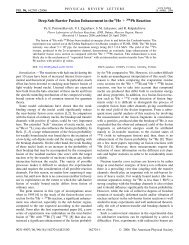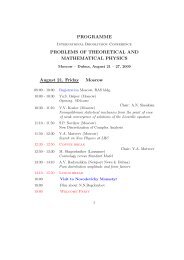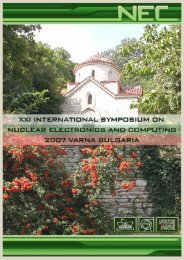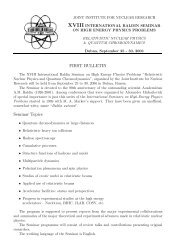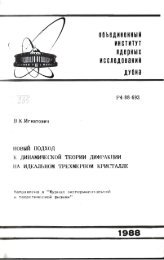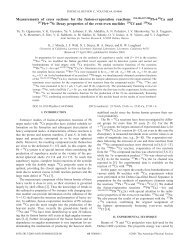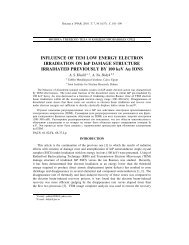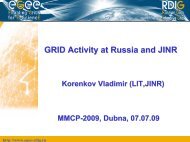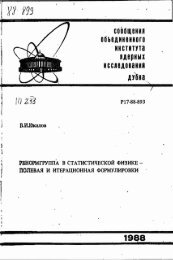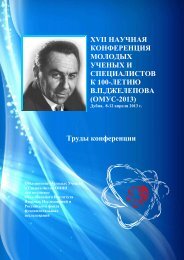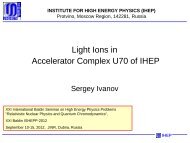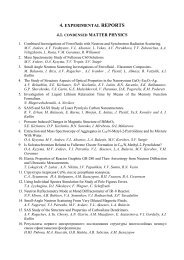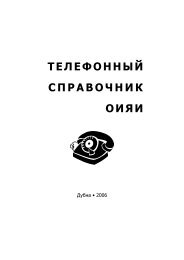Joint Institute for Nuclear Research Relativistic ... - Index of - JINR
Joint Institute for Nuclear Research Relativistic ... - Index of - JINR
Joint Institute for Nuclear Research Relativistic ... - Index of - JINR
You also want an ePaper? Increase the reach of your titles
YUMPU automatically turns print PDFs into web optimized ePapers that Google loves.
ON MANIFESTATION OF QUARK-HADRON DUALITY<br />
VIA THE ADLER D-FUNCTION<br />
O.P. Solovtsova 1,2† and V.G. Teplyakov 2<br />
(1) Gomel Technical University, Gomel 246746, Belarus<br />
(2) BLTP, <strong>JINR</strong>, Dubna 141980, Russia<br />
† E-mail: olsol@theor.jinr.ru<br />
To compare theoretical results and experimental data one <strong>of</strong>ten uses the concept <strong>of</strong><br />
quark-hadron duality, which establishes a bridge between quarks and gluons, a language<br />
<strong>of</strong>theoreticians, andreal measurements withhadrons per<strong>for</strong>medby experimentalists. The<br />
ideaquark-hadrondualitywas<strong>for</strong>mulatedinthepaperbyPoggio, Quinn,andWeinberg[1]<br />
as follows: Inclusive hadronic cross sections, once they are appropriately averaged over an<br />
energy interval, must approximately coincide with the corresponding quantities derived<br />
from the quark-gluon picture. It is clear that it will be most fruitful to connect measured<br />
quantities with “simplest” theoretical objects. Some single-argument functions which are<br />
directly connected with experimentally measured quantities can play the role <strong>of</strong> these<br />
objects.<br />
In this talk we concentrate on physical quantities and functions connected with the<br />
Adler D-function [2]. This function defined in the Euclidean region <strong>for</strong> positive momentum,<br />
Q 2 = −q 2 > 0, is a smooth function without traces <strong>of</strong> the resonance structure.<br />
There<strong>for</strong>e one might expect that use <strong>of</strong> the Adler function is useful and that it more precisely<br />
reflects the quark-hadron duality, than, <strong>for</strong> example, use <strong>of</strong> the smeared quantity,<br />
R ∆ (q 2 ), defined in the timelike region [1]. The D-function was studied in a number <strong>of</strong><br />
papers (see [4] <strong>for</strong> more details).<br />
Thetheoretical approachthatweuse hereisbased onthenonperturbative a-expansion<br />
method (see [3]) which leads to a new small expansion parameter. Even going into the<br />
infrared region <strong>of</strong> small momenta where the running coupling becomes large and the<br />
standard perturbative expansion fails, the nonperturbative expansion parameter remains<br />
small and the approach holds valid. It is important that this method supports the correct<br />
analytic properties <strong>of</strong> the Adler function. Using the D-function in the theoretical description,<br />
we found good agreement between our results and corresponding experimental data<br />
downtothelowest energyscale (thatisnot calculablewithin standardperturbative QCD)<br />
both <strong>for</strong> the timelike and Euclidean quantities. We investigate the reason <strong>of</strong> such good<br />
agreement and as a result we <strong>for</strong>mulate a criterion which we call as the R – D self-duality.<br />
References<br />
[1] E.C. Poggio, H.R. Quinn, and S. Weinberg, Phys. Rev. D13, 1958 (1976).<br />
[2] S.L. Adler, Phys. Rev. D10, 3714 (1974).<br />
[3] A.N. Sissakian and I.L. Solovtsov, Phys. Part. Nucl. 30, 461 (1999).<br />
[4] S.L. Adler, “Adventures in theoretical physics: Selected papers <strong>of</strong> Stephen L. Adler:<br />
Drafts <strong>of</strong> commentaries”, hep-ph/0505177, 117 pp.<br />
118



